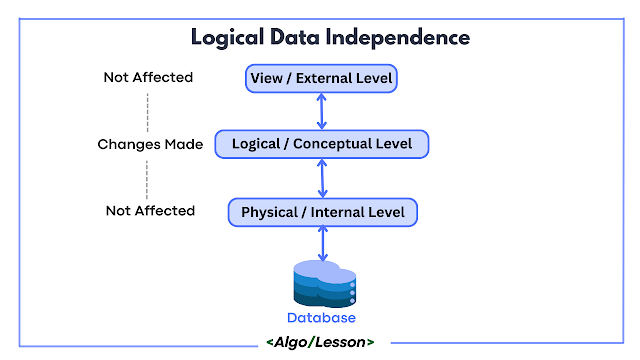What is Data Independence?
Data Independence refers to the capacity to change the schema at one level of a database system (e.g., storage or structure) without altering the schema at the next higher level (e.g., user views or applications). It enables abstraction between how data is stored, how it’s structured, and how users interact with it.
There are two types of data independence:
- Logical Data Independence
- Physical Data Independence
Logical Data Independence.
Logical Data Independence is the ability to change the conceptual structure of the database (like adding or modifying tables, columns, or relationships) without changing the external structure of how users or applications access the data.
Example: Let’s say a column PhoneNumber is added to the Student table. If the user views don’t need this column, no changes are needed in how users query the database.
Key Benefits of Logical Data Independence:
- Helps in restructuring tables, adding new fields, or merging data without disturbing users.
- Supports evolving business logic and entity relationships.
- Crucial for large-scale applications with multiple user roles and views.
How to achieve Logical Data Independence?
- Use of Views: Applications and users interact with views that are mapped to the logical schema. Changes to the schema can be managed behind the scenes without changing the views.
- Abstraction through External Schema: The external schema defines what data the user sees, not how it's structured. So, even if the underlying logical model changes, the view stays the same.
- DBMS Support: Most modern DBMS systems support logical data independence through metadata management, view mechanisms, and query rewriting.
Physical Data Independence.
Physical Data Independence is the ability to change (internal schema) how the data is stored internally (like changing file structures, indexes, or compression methods) without affecting (conceptual schema) how the data is accessed by users or applications.
Example: If you change the way data is stored (e.g., from heap storage to B-tree indexing for faster access), users and applications don’t need to modify their queries.
Key Benefits of Physical Independence:
- Allows performance tuning and storage optimization.
- Ensures the database remains efficient even if hardware or indexing strategies change.
- Makes data migration and infrastructure upgrades easier.
How to achieve Physical Data Independence?
- DBMS Abstraction Layer: The DBMS acts as an abstraction layer between the physical storage and the logical schema. It translates user queries into low-level storage operations, shielding users from physical changes.
- Metadata Management: Information about data storage (like indexing methods, file locations, and compression) is stored in metadata. This allows physical changes without modifying logical definitions.
- Use of Indexes and Storage Techniques: You can add indexes, change data block sizes, or switch to SSDs without altering tables or affecting application queries.
Difference Between Logical and Physical Data Independence.
| Logical Data Independence | Physical Data Independence |
|---|---|
| Ability to change the logical schema without changing the external views or applications. | Ability to change the physical storage without altering the logical schema or applications. |
| Protects user views and application programs from changes in logical structure. | Protects the logical schema and application from changes in physical data storage. |
| Adding a new column or table does not affect existing user views. | Changing data file format or indexing does not affect logical structure or queries. |
| Harder to achieve as applications depend heavily on the logical structure. | Easier to achieve as internal changes are hidden by the DBMS engine. |
| Useful during database redesigns, data model changes, or schema upgrades. | Useful during performance optimization, storage upgrades, or disk reorganization. |
| Logical changes may affect multiple applications if independence is not maintained. | Physical changes rarely affect applications if independence is well-implemented. |
| Requires high-level data abstraction and flexible application design. | Achieved through DBMS internals like metadata, indexes, and query optimization layers. |
Conclusion.
Data independence is crucial in modern database systems to ensure flexibility, security, and efficient data management. By separating the physical, logical, and user layers, developers can modify, scale, or optimize databases without disrupting applications or user experiences. Mastering Logical and Physical Data Independence is essential for any database administrator or backend developer.


No comments:
Post a Comment